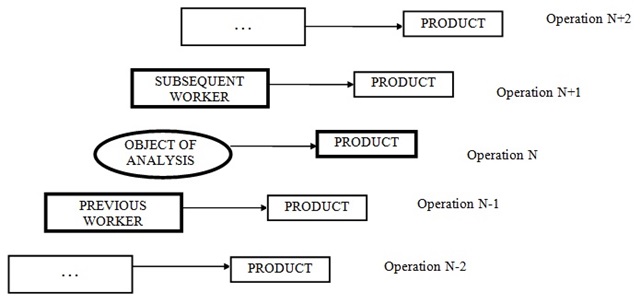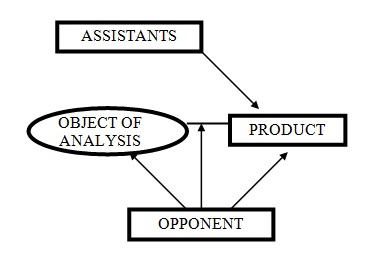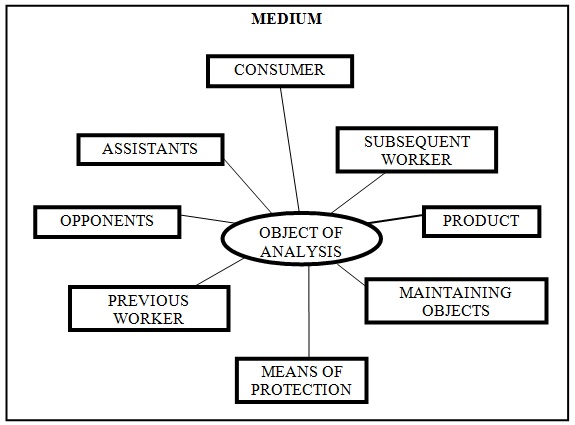INTRODUCTION
One of the most important stages of system analysis is determining requirements imposed on the object being analyzed by the closest environment - hypersystem. For these requirements to be revealed, it is necessary to determine with greatest possible precision the hypersystem's objects with which the object analyzed interacts at one or another life cycle stage.
The urgency of this problem grows if the object analysis is performed with software of IM-VEA, Optimizer type. In such a situation, the software should either determine standard objects of hypersystem by itself or give the user a hint of what these can be like. For this purpose, the program should be provided with a universal list of standard objects of hypersystem for each stage of the object's life cycle.
In the works dedicated to the system analysis (1), (2), (3), (4), (5), (6), one can find some lists of standard objects of hypersystem. The lists, however, are not comprehensive and contain, along with the names of standard objects (for instance, 'object of function', 'environment'), such indefinite names as 'other elements of hypersystem' or 'systems interacting with the elements of the upper level of the object analyzed' (4. p.17-18).
MODEL OF INTERACTION BETWEEN OBJECT AND HYPERSYSTEM
To make a list of standard objects of hypersystem, a standard model of interaction of the engineering object with the hypersystem should be created.
It would be better to create such a model for the operation stage since this is just the time when the object interacts with the maximum number of surrounding objects. Besides, this stage is most interesting from the user's point of view.
The following principles of creating a standard model are proposed.
1. The object being analyzed is one of the product-working objects
Any engineering object is created for producing a required effect on another object. The latter one is called "the product".
At any stage of life cycle, the product is exposed to the action of various objects. We can say, that the product 'is worked' by these objects. Because of this, the object under analysis may be considered as one of a series of objects which sequentially work the product. Since the object analyzed participates in working the product together with other objects, it can interact with these.
The hypersystem object which works the product prior to the object analyzed may be called 'the previous worker', while the one that works the product after the object analyzed may be called 'the subsequent worker' (see Fig.1).

Fig. 1. Object working process
Simultaneously with the object analyzed, the product may be worked by other objects. It looks as if they help the object analyzed and we shall call them arbitrarily "assistants".
In such a situation, however, the contrary is also true. Objects or natural phenomena may exist which prevent object working. These objects may spoil the object analyzed, prevent it from acting on the product or spoil the product itself. Such objects may be called the "opponents" (see Fig. 2).

Fig. 2. Simultaneous working of the product
2. For the object to work, it should be maintained
In the process of working the product, the object uses part of its resources and besides it may be contaminated or damaged, so it should be maintained during a preset period of time.
The whole variety of maintaining objects may be divided into the following groups:
The personnel - persons maintaining the object analyzed and the product.
The means of maintenance - technical devices used by the personnel for maintaining the object of analysis and assuring uninterrupted work of the object.
The means of maintenance can be classified into the following groups:
- transportation facilities,
- loading facilities,
- assembly, disassembly, cleaning facilities,
- energy source,
- supply system,
- control system
The positioning facilities are engineering and natural objects which determine and maintain the position of the object analyzed in space.
The positioning facilities fall into two groups: supports, holders.
3. The object is always located in a medium
The medium is natural or artificial fields and substances in which the object analyzed is located and functions.
Any object is always located in some medium and interacts with this in one or another way. That is why the medium is a standard object of hypersystem for any object being analyzed.
4. For the object to exist, it should be protected
The object of analysis, product, as well as the medium in which they are located and function may be considered as a sort of system. For this system to function, each of its elements should be protected against possible harmful actions on one another or the action of other objects connected with them.
All the means of protection may be divided into the following groups:
- object of analysis protection systems,
- product protection systems,
- medium protection systems.
At the initial stages of object evolution, all of the object's resources are only used to fulfill the main function, whereas the object is protected against undesirable external actions by means of special protection systems.
In the process of evolution, there emerge subsystems of the object, said subsystems providing full or partial protection of the object against harmful actions.
5. The object is needed by the consumer
The consumer is a person who uses the object analyzed and the results of its functioning for achieving certain purposes.
All the above-mentioned objects form the list of the closest standard objects of hypersystem (see Fig. 3). Depending on the purposes of analysis, this list may be either reduced or expanded.

Fig. 3. Standard object of hypersystem for the operation stage
For the rest of the object's life cycle stages, the list will not contain the product and other standard objects connected with product working. At these stages, the object itself is the product and is worked by the hypersystem objects.
CONCLUSION
- Proposed is the standard model of hypersystem for engineering objects.
- The proposed model superficially is similar for all stages of the object's life cycle, except the operation stage.
- Standard objects of hypersystem for different stages of the object's life cycle differ in specific content.
LITERATURE
- Stanford L. Optner. Systems analysis for business and industrial problem solving. New Jersey, Prentice-Hall, Include, Englewood Cliffs, 1965.
- Devoino I.G. Towards the complication of engineering systems. TRIZ magazine, 2.1,91.p.56-63.
- Ilyichev A.V. Efficiency of equipment designed: basics of analysis. - M.: Mashinostroyenie, 1991. - 336 p.
- Basic provisions of the methods of performing value-engineering analysis. - M.: Inform-VEA, 1991. - 40 p.
- Polovinkin A.I., Bobkov N.K., Dvoryankin A.M. et al. Search design process control/ Ed. A.I.Polovinkin. M.: Radio and Communication, 1981. - 244 p.
- Skuratovich A.I. Standard objects of hypersystem for engineering objects. / Summary of reports of the international scientific-practical seminar 'IM 96 Project' (Minsk, 4-6 January, 1996), p.89.
| 



 вверх
вверх